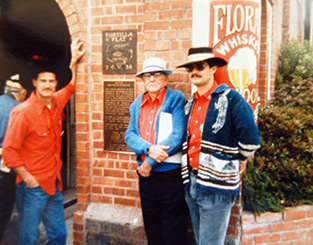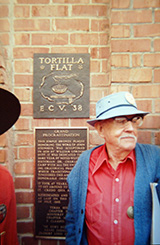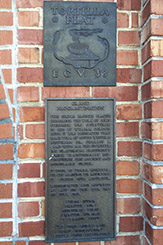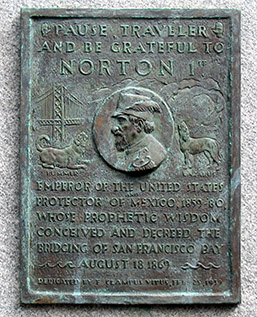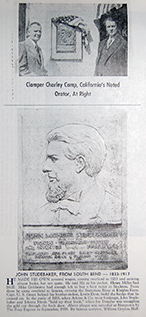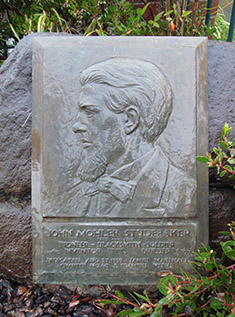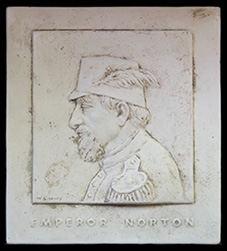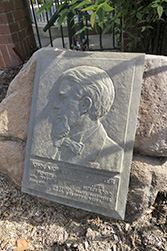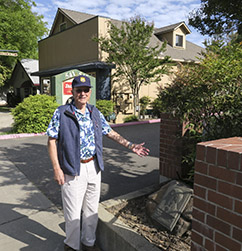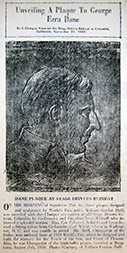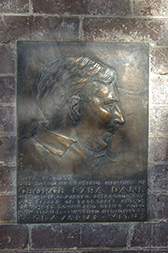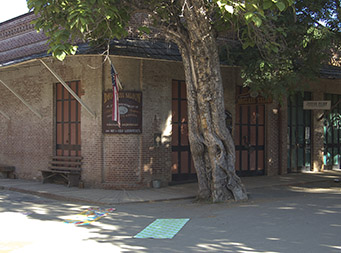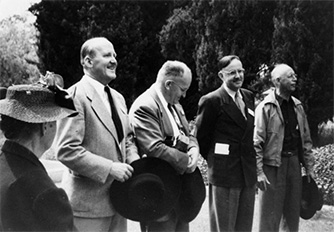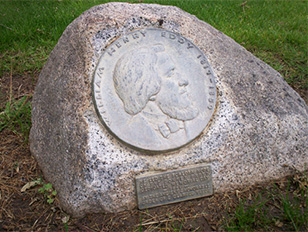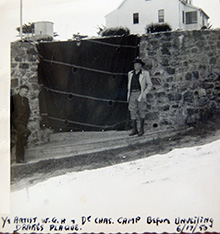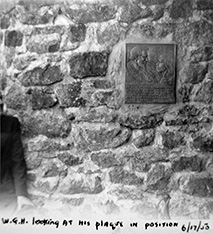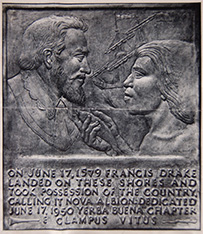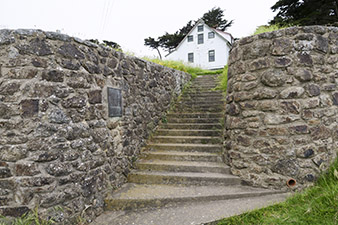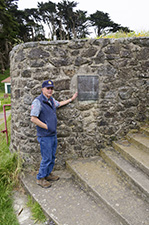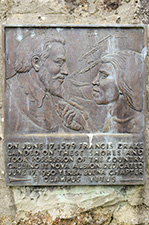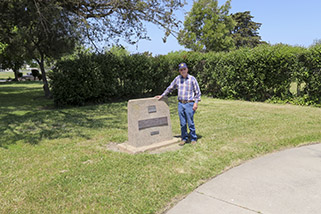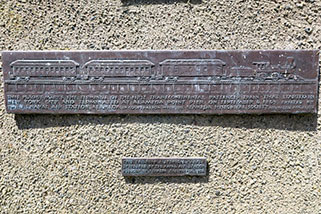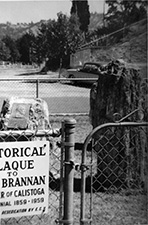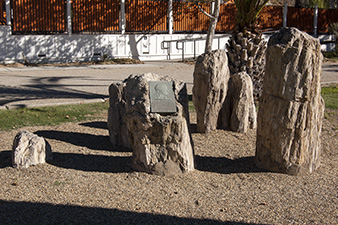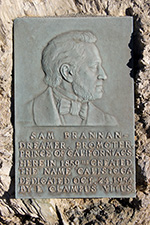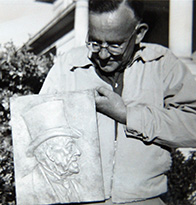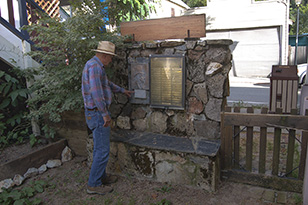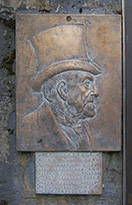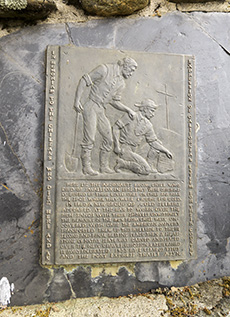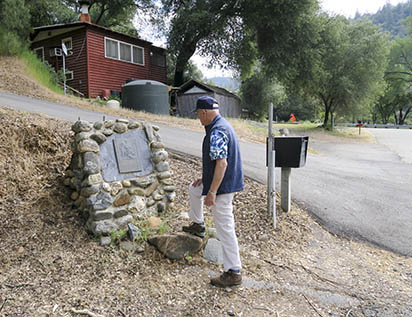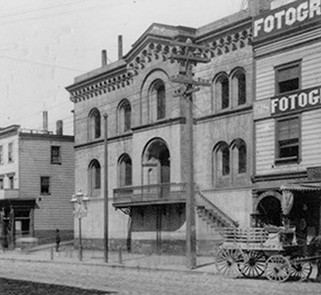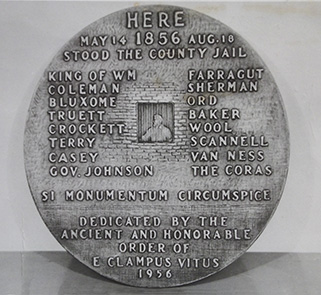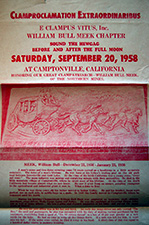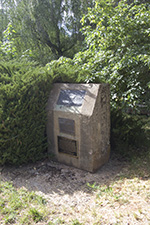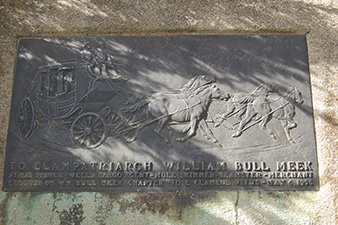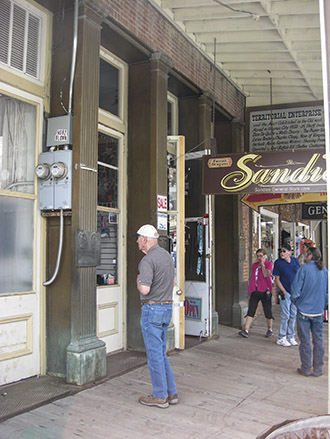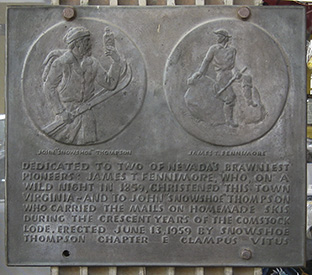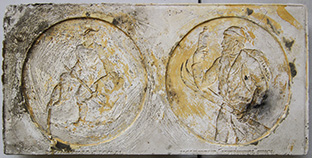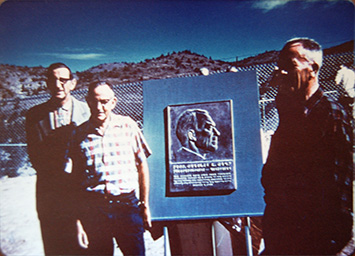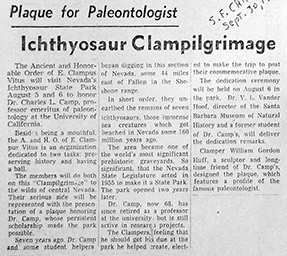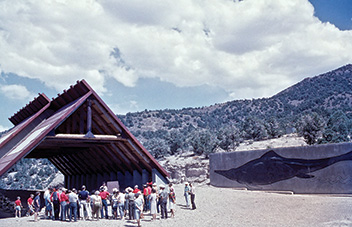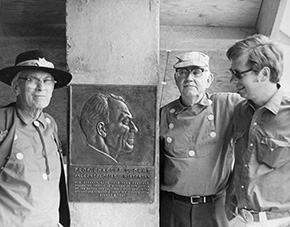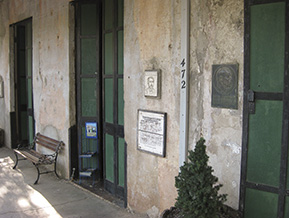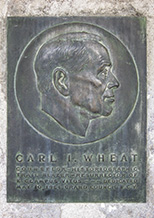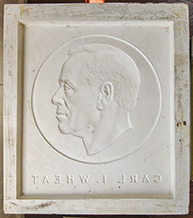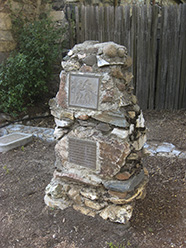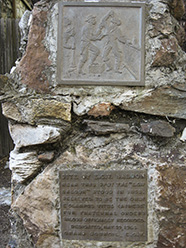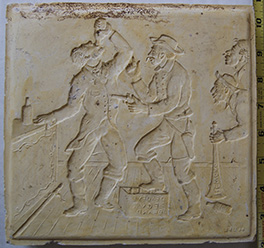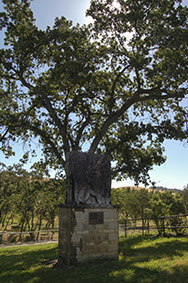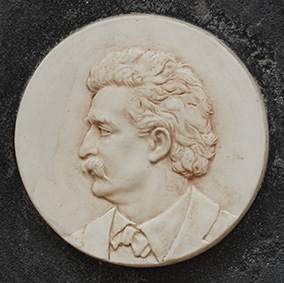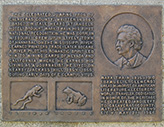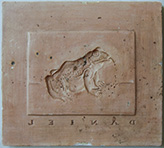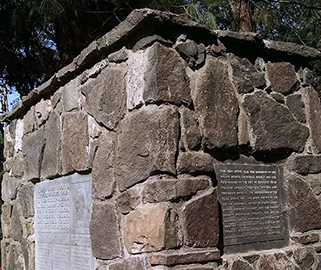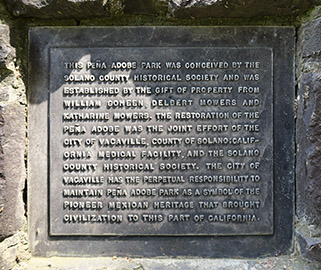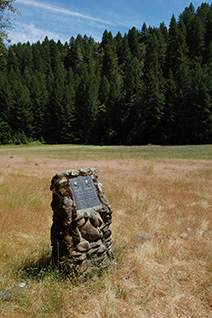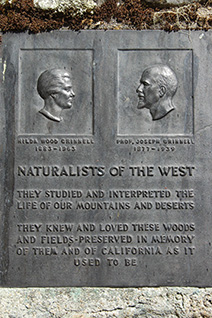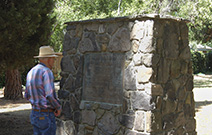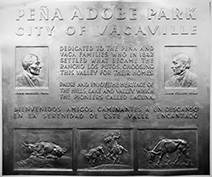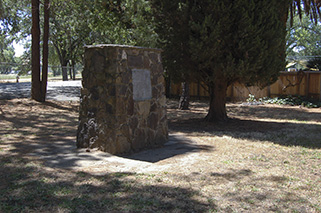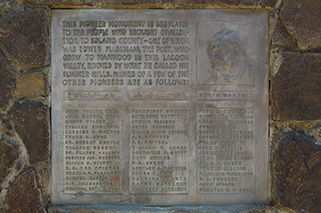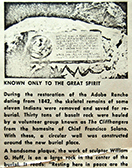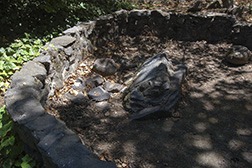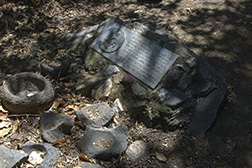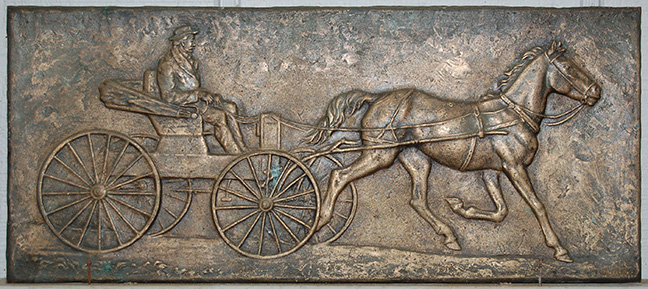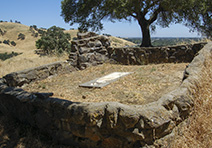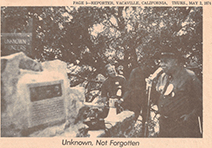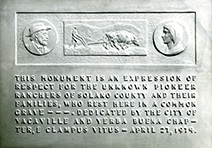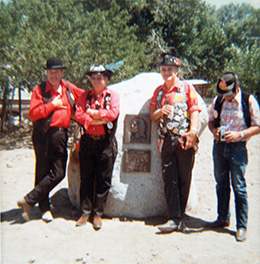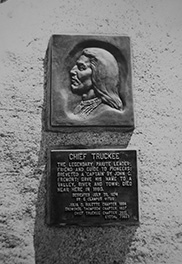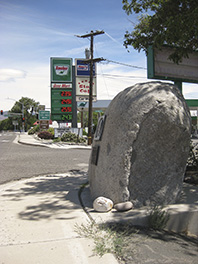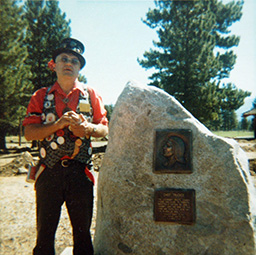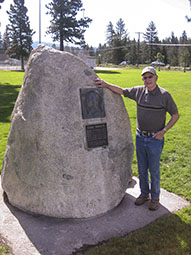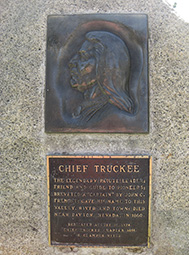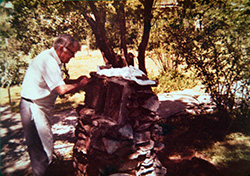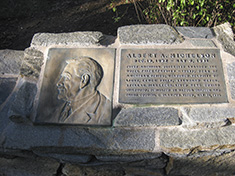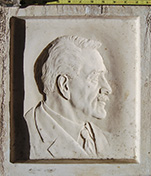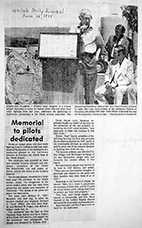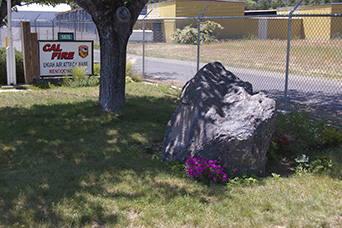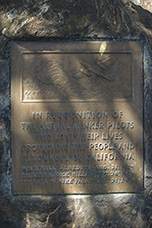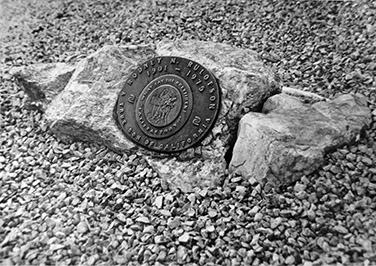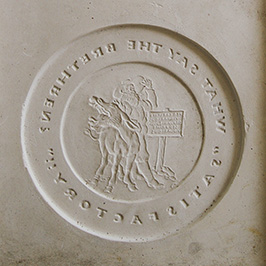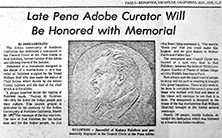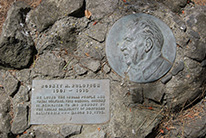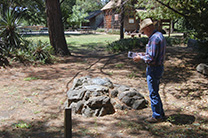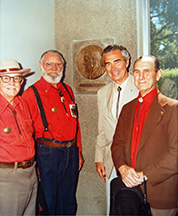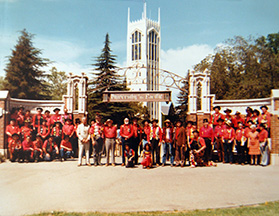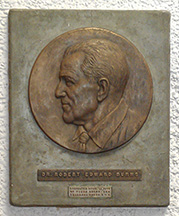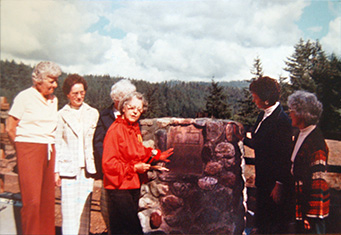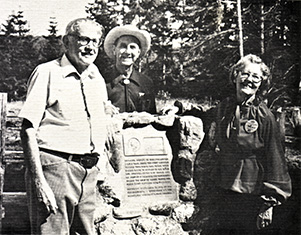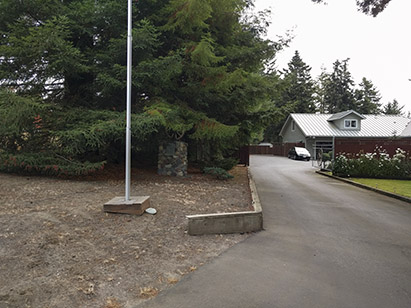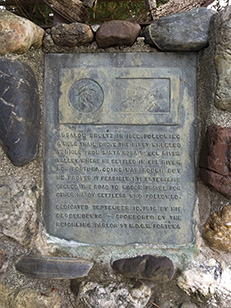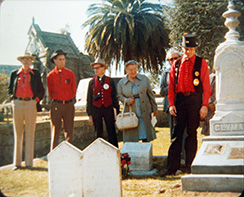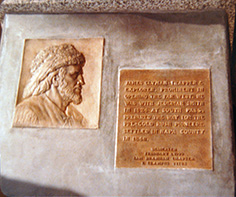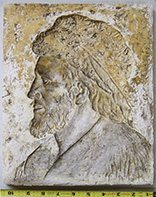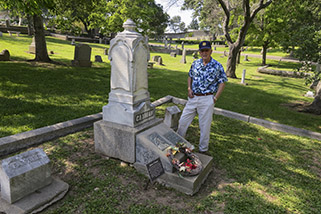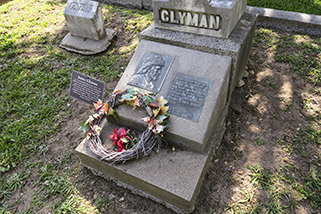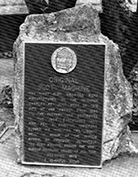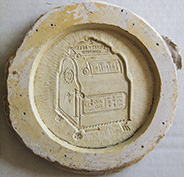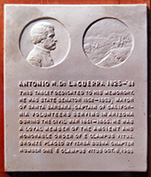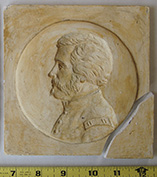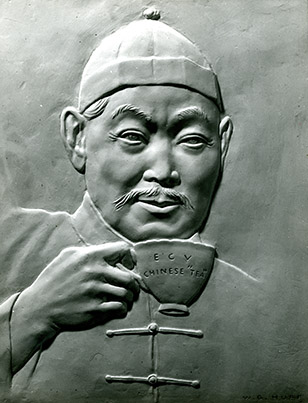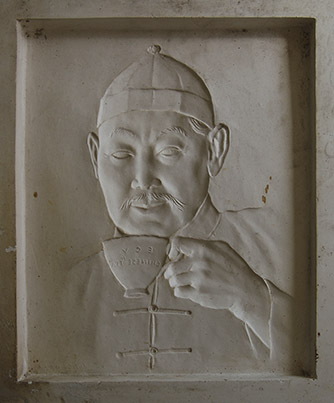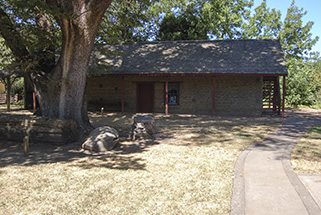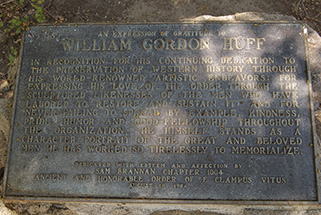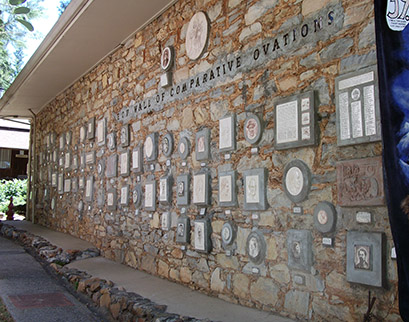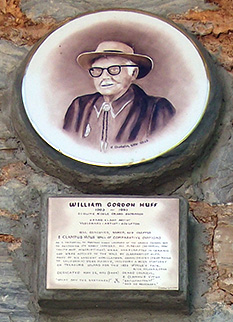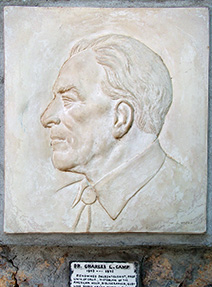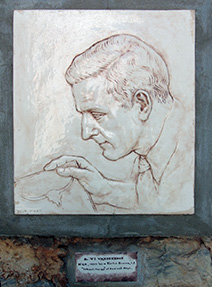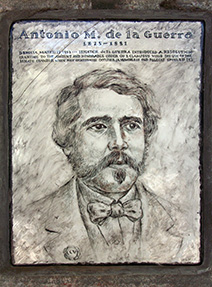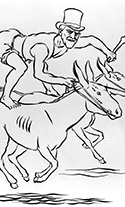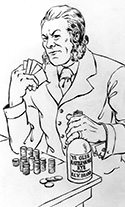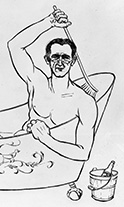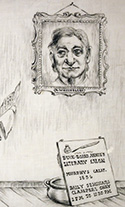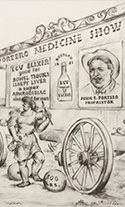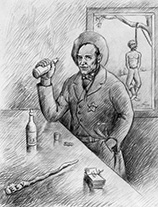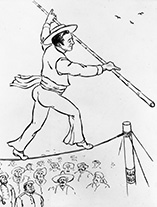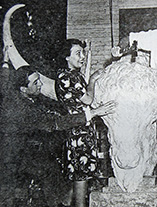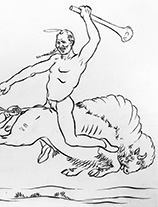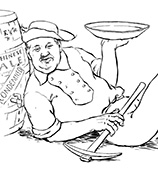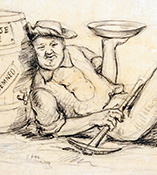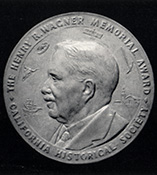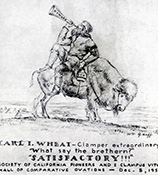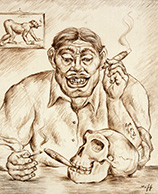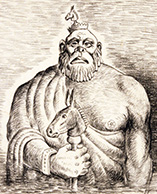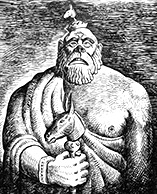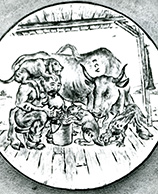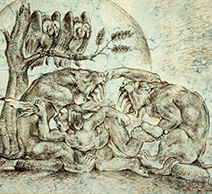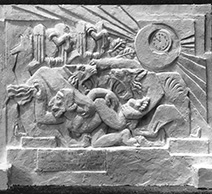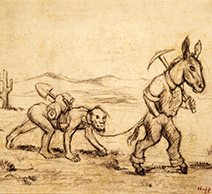A UCMP special exhibit
The Art of Sculptor William Gordon Huff
Part III: E Clampus Vitus and Historical Plaques
Open the Sources page for Part III in a new window.
The Ancient and Honorable Order of E Clampus Vitus had its roots in the Gold Rush days of California. Created by and for miners, ECV was the antithesis of other organizations, such as the Masons and the Elks, whom the miners felt took themselves much too seriously. Clampers "looked on the absurdity of life as something to be cherished." But by 1900, E Clampus Vitus had essentially disappeared. In 1931, San Francisco historian Carl Wheat, who had found many references to E Clampus Vitus in his researches, pitched the idea of reviving ECV to his friends George Ezra Dane and Leon O. Whitsell. The three were contacted by Adam Lee Moore, "the last known survivor of the old ECV." Moore "passed on to Wheat and company all he remembered of the rites, rituals, traditions, and legends of E Clampus Vitus, providing an invaluable link to the past." Wheat et al. established the first new chapter of ECV, dubbed Yerba Buena No. 1. Other chapters subsequently popped up throughout California and beyond. "ECV's 'serious' side consists of finding, researching, and dedicating plaques to sites, incidents, and people in Western history that might otherwise be overlooked. They have plaqued hundreds of locations from ghost towns to saloons, from bordellos to ranchos, from heroes to madmen."1
William Gordon Huff most likely became involved with E Clampus Vitus through Charles Camp. Camp was not only a noted Berkeley paleontologist, but a historian of the American West; he was one of the earliest members of the reborn Order and a member of the Yerba Buena No. 1 chapter. He also served as the chapter's Noble Grand Humbug in 1938.
By 1938, Camp had known Huff for over two years and was no doubt aware of his plaque-making history and abilities. On behalf of E Clampus Vitus, Camp recruited Huff to create a bronze plaque commemorating John Steinbeck's recent book, Tortilla Flat (published in 1935). This was Huff's first plaque for the Order, however, it would not be mounted for another 47 years! As Clamper Carl Briggs explained it in a March 1984 letter:
Yerba Buena Chapter NGH [Noble Grand Humbug] Charles Camp led their members to Cannery Row in 1938 to dedicate a plaque commemorating the site of Steinbeck's famous 'Tortilla Flat.'
The dedication did indeed take place, but the chapter had failed to make provisions for mounting the plaque and they took it back home with them. The bronze casting became lost and quite probably donated itself to the war effort.2
But Huff had saved the mold and 47 years later, the plaque was recast and finally mounted (by the Yerba Buena Chapter No. 1 and Monterey Viejo Chapter No. 1846), with traditional ECV pomp, at the corner of Prescott Avenue and Wave Street in Monterey on July 13, 1985. It can still be seen there today.3
Click on any image to see a larger version. Left: Huff with grandsons Kevin (left) and Brenden Phipps at the rededication of the Tortilla Flat plaque in Monterery, July 13, 1985. Huff was 35 when he made the original plaque in 1938; he was 82 when it was finally installed. HFA. Center: Huff and the mounted plaque. Note how shiny the text was. HFA. Right: This photo of the plaque was taken in 2014. The text has darkened considerably. Photo by Ian Brown.
Huff's next plaque made for ECV was dedicated in 1939 but it too would not be mounted until years later. Legend had it that San Francisco's self-proclaimed emperor, Joshua Norton, had decreed that a bridge be built between Oakland and San Francisco 50 years earlier in 1869. With the bridge having been built—it opened to traffic on November 12, 1936—E Clampus Vitus felt that Norton should get some of the credit, so they engaged Huff to create a plaque honoring the man. They intended to place the plaque on the bridge itself but the Bridge Authority said no. Sixteen years later, the Clampers installed the plaque in the lobby of the Cliff House on November 11, 1955. The plaque remained there until 1986 when it was moved to the Transbay Terminal in downtown San Francisco, the rededication taking place on the 50th anniversary of the Bay Bridge's opening. The transit center has since been completed but it is unknown whether the Norton plaque was remounted within the facility.4
One does not simply join ECV—one must be invited. Following the dedication (but failed mounting) of the Norton plaque on February 25, 1939, and with Camp as his sponsor, Huff was taken to Treasure Island and initiated into the Order (the GGIE had opened a week earlier). Initially a Damn Fool Doorkeeper,5 Huff later attained the status of Sublime Noble Grand Humbug and in 1969 was appointed Honorary Clampatriarch.6 Huff was a popular and well-liked member of ECV. He used his artistic abilities for the betterment and amusement of the Order and in short order became its official "Clampartist." Both Huff and Camp remained active in the Order until the end of their days.
Huff had honed his skills with relief sculpture during his time on the East Coast (see "Bennington, Vermont" on page 1) and he would use those skills to produce many historical plaques—both bronze and ceramic—for ECV, other historical organizations, and the Navy. His bronze plaques are scattered throughout northern California, primarily in the former mining regions of the Sierra Nevada and its foothills, however, Huff plaques can be found in Vermont, New York, Massachusetts, Nevada, Florida, and even Antarctica.7 It is interesting that today, out of Huff's entire oeuvre, it is his ECV work that has turned out to be his most accessible and permanent (his Chief Solano statue and the Berlin-Ichthyosaur State Park ichthyosaur relief being the only exceptions).
The bronze plaques
After the Tortilla Flat and Emperor Norton bronze plaques, Huff went on to create several more for ECV and other historical organizations (plaques made for the Navy are discussed on page 4). This is a list of the known plaques in order of their dedication:
1939: John "Wheelbarrow" Studebaker in Placerville, El Dorado County, California; dedicated on August 27 by the James W. Marshall Chapter No. 49 (designated as California Registered Historical Landmark No.142).1
Click on any image to see a larger version. Top left: Huff's Emperor Norton plaque at the old Transbay Terminal. Photo by Nagle at en.wikipedia (CC BY-SA 3.0). Top center: A short article from The Pony Express announcing the dedication of the Studebaker plaque in Placerville (formerly Hangtown). From the top photo, it appears that Charles Camp was the master of ceremonies. HFA. Top right: The Studebaker plaque as it looks today. The plaque apparently was moved from its original location. Courtesy of HMdb.org; photo by Barry Swackhamer. Bottom left: A ceramic tile with Emperor Norton's relief. HFA, on indefinite loan to Peña Adobe's Mowers-Goheen Museum. Bottom center: The Studebaker plaque is right by the sidewalk in front of 541 Main Street, Placerville. Photo by David Smith. Bottom right: Tim Huff with his father's Studebaker plaque. Photo by David Smith.
1947: George Ezra Dane in the mining town of Columbia, Tuolumne County, California; dedicated on September 21 by E Clampus Vitus.2
1949: William Henry Eddy at Oak Hill Memorial Park, San Jose, Santa Clara County, California; dedicated May 30 by E Clampus Vitus.3
Click on any image to see a larger version. Top left: An article from The Pony Express announcing the dedication of the Dane plaque in Columbia, 1947. HFA. Top center: The plaque as it appears today. Photo by David Smith. Top right: The plaque is on an exterior wall of the Douglass Saloon; it's just left of the small patch of sunlight. Photo by David Smith. Bottom left: Huff (second from right) attending the 1949 dedication of the William H. Eddy plaque at Oak Hill Memorial Park, San Jose, along with fellow Clampers and Eddy descendants. From the Clyde Arbuckle Photograph Collection; California Room, San Jose Public Library. Bottom right: The Eddy plaque. Courtesy of Jack "Jackrabbit" Furlow, Mountain Charlie 1850 chapter of E Clampus Vitus.
1950: Sir Francis Drake at the historic Lifeboat Station near Chimney Rock, Pt. Reyes, Marin County, California; dedicated June 17 by the Yerba Buena No. 1 Chapter.4
Click on any image to see a larger version. Top left: Camp (right) and Huff prepare to unveil the Drake plaque at the historic Pt. Reyes Lifeboat Station, not far from the Chimney Rock parking area. HFA. Top center: Huff and the mounted plaque. HFA. Top right: The Drake plaque. HFA. Bottom left: The Drake plaque's location has not changed. It is still at the bottom of the stone steps leading up to the officer-in-charge's residence. Photo by David Smith. Bottom center: Tim Huff with his father's Drake plaque. Photo by David Smith. Bottom right: The Drake plaque as it looks today (May 2019). Photo by David Smith.
1952: Transcontinental railroad terminus on West Mall Square, opposite the Alameda City Public Works Department, Alameda, California; dedicated August 22 by the Alameda Naval Air Station, in cooperation with the Alameda Historical Society.
Click on either image to see a larger version. Left: Tim Huff with the transcontinental railroad terminus plaque at West Mall Square. Photo by David Smith. Right: This is one of four Huff bronze plaques in Alameda.See the other three on the next page. Photo by David Smith.
1954: Sam Brannan in Calistoga, Napa County, California; dedicated October 24 and rededicated in 1959 by E Clampus Vitus. Located at the entrance to Indian Springs Resort & Spa.5
Click on any image to see a larger version. Left: Mounted on a petrified tree stump, the Brannan plaque was surrounded by a chain-link fence at the time of its 1959 rededication. HFA. Center: The Brannan plaque stump is just one of several petrified tree stumps in a small "grove" near the entrance of Indian Springs Resort & Spa in Calistoga. Photo by David Smith. Right: The Brannan plaque. Photo by David Smith.
1955: Adam Lee Moore in Downieville, Sierra County, California; dedicated (specific date unknown) by the Yerba Buena Chapter No. 1.6
Click on any image to see a larger version. Left: Huff shows off the Moore plaque. HFA. Center: Huff's son Tim examines the Moore plaque in Downieville. Photo by David Smith. Right: The Moore plaque as it looks today. Photo by David Smith.
1955: The Chili Bar Miners plaque at Chili Bar on the South Fork of the American River, north of Placerville, El Dorado County, California; dedicated (specific date unknown) by E Clampus Vitus and the Pony Express Trails Association.
Click on either image to see a larger version. Left: This plaque is located at the inside corner of the intersection of Chili Bar Lane and Chili Bar Court on the north shore, South Fork of the American River. Photo by David Smith. Right: Tim Huff with the Chili Bar Miners plaque. Photo by David Smith.
1956: Old San Francisco county jail, intersection of Broadway and Kearny, San Francisco, San Francisco County, California; dedicated April 28.7
Click on either image to see a larger version. Left: The jail at Broadway and Romolo Place. Photo courtesy of Richard Dyer and the San Francisco Sheriff's Department History Research Project. Right: Huff's plaque of the old San Francisco County jail. HFA.
1956: William Bull Meek in Camptonville, Yuba County, California; dedicated May 6 by the William Bull Meek Chapter No. 10.8
Click on any image to see a larger version. Left: Although the text on the Meek plaque says that the dedication was on May 6, 1956, this poster suggests that it may have taken place more than two years later. HFA. Center: The Meek plaque is mounted on a stone base near a sharp bend in Cleveland Avenue. Photo by David Smith. Right: The Meek plaque. Photo by David Smith.
1959: John "Snowshoe" Thompson and James T. Fennimore, Territorial Enterprise Building, Virginia City, Nevada; dedicated June 13 by the Snowshoe Thompson Chapter 1827.9
Click on any image to see a larger version. Left: Tim Huff checks out the Thompson/Fennimore plaque on the Territorial Enterprise Building in Virginia City, Nevada. Photo by David Smith. Top right: The Thompson/Fennimore plaque. Photo by David Smith. Bottom right: The plaster mold for the Thompson/Fennimore plaque resides in the Huff Family Archives. Photo by David Smith.
1961: Charles Lewis Camp at Berlin-Ichthyosaur State Park, east of Gabbs, Nevada; dedicated three times: August 6, 1961; August 20, 1966; and May 12, 1973.10
Click on any image to see a larger and complete version. Top left: Huff with his plaque of Camp at the initial 1961 dedication ceremony, Berlin-Ichthyosaur State Park, Nevada. Standing behind Huff is V.L. VanderHoof, a former student of Camp's and then-Director of the Santa Barbara Museum of Natural History. HFA. Top right: A September 30, 1961, San Francisco Chronicle article about the upcoming event to honor Camp. HFA. Bottom left: Clampers and friends of Charles Camp gather at the park once again in 1966 for dedication #2. UA. Bottom right: Camp, Huff and Nevada's Attorney General Robert List at the 1973 dedication when the plaque was finally mounted. HFA; photo by Carl Briggs.
1964: Carl Wheat, south exterior wall of the Old Timers' Museum (Peter Travers Building), 470 Main Street, Murphys, California; dedicated May 30 by ECV's Grand Council.11
Click on any image to see a larger version. Left: The Wheat plaque is described as being on the front of the Old Timers' Museum, but in this photo it would appear to be on the front of the adjoining Thompson Building. A ceramic Huff plaque of Antonio de la Guerra can be seen to the left of the Wheat plaque (see the section on ceramic plaques below). Photo by David Smith. Center: The Wheat plaque. Photo by David Smith. Right: Huff's plaster mold for the Wheat plaque is still in pristine condition. HFA; photo by David Smith.
1965: ECV saloon, a two-piece bronze plaque placed in a stone monument, west end of Main Street, Murphys, Calaveras County, California; dedicated May 29 by ECV's Grand Council.12
Click on any image to see a larger version. Left: The ECV saloon plaque near the west end of Main Street in Murphys. Photo by David Smith. Center: A closer look at the two-piece plaque. Photo by David Smith. Right: The plaster mold for this plaque resides in the Huff Family Archives. Photo by David Smith.
1966: Mark Twain and the Celebrated Jumping Frog of Calaveras County at Frogtown USA, Calaveras County Fairgrounds, Angels Camp, California; dedicated May 21 by the Matuca Chapter No. 1849.13
Click on any image to see a larger version. Left: The Twain plaque is on this monument at Frogtown USA, Angels Camp. Photo by David Smith. Center: A ceramic version of Huff's Twain bas-relief. HFA; photo by David Smith. Top right: A close-up of the plaque. Photo by David Smith. Bottom right: The plaster mold for the jumping frog Daniel is in the Huff Family Archives. Photo by David Smith.
1967: Donor plaque for the Peña Adobe; Vacaville, Solano County, California; dedicated June 2 by the Vacaville Heritage Society and Solano County Historical Society.14
Click on either image to see a larger version. Left: The donor plaque is easy to miss because it's on the south end of the stone monument near the entrace to Peña Adobe Regional Park. Courtesy of the Peña Adobe Historical Society. Right: This may be the sole text-only plaque that Huff ever made that had no companion piece with artwork. Photo by David Smith.
1967: Joseph and Hilda Wood Grinnell at the Angelo Coast Range Reserve, University of California Natural Reserve System, Mendocino County, California; probably dedicated early summer. The plaque was a gift to The Nature Conservancy from students, colleagues, friends and family of the Grinnells.15
1968: Peña Adobe Park at the entrance to Peña Adobe Regional Park, Vacaville, California; there is no dedication date on the plaque, nor is there a record of when this was done in the Huff Family Archives, however, this is one of the rare instances in which Huff both signed and dated the plaque.16
Click on any image to see a larger version. Left: The Grinnell plaque is mounted on a stone monument at the edge of a remote meadow within the Angelo Coast Range Reserve. Photo by David Smith. Center: The Grinnell plaque. Photo by David Smith. Top right: Tim Huff admires his father's Peña Adobe Park plaque. Photo by David Smith. Bottom right: The Peña Adobe Park plaque. Huff's signature and the year are at the bottom right corner of the plaque and are cut off in this photograph. HFA.
1969(?): Edwin Markham and Solano County pioneers at the entrance to Peña Adobe Regional Park, Vacaville, California; dedicated (date unknown) by the Solano County Historical Society.17
1969: Plaque dedicated to the original inhabitants (Native Americans) who once lived on the grounds of today's Peña Adobe Regional Park. The plaque is mounted on a large rock atop the burial mound just north of the Park's Mowers-Goheen Museum. During renovations and landscaping work beginning in 1958, the skeletons of 11 Native Americans had been recovered from a two-acre area. The remains were saved and reburied at the Park in September.18
Click on any image to see a larger and complete version. Top left: The Markham/Solano County pioneers plaque is on the back (west) side of the stone monument near the entrace to Peña Adobe Regional Park. Photo by David Smith. Top right: The Markham/Solano County pioneers plaque. Photo by David Smith. Bottom left: An article from an unknown publication describing the reburial of the Native American skeletal remains and Huff's plaque. HFA. Bottom center: A stone wall surrounds the burial place. Photo by David Smith. Bottom right: Huff's plaque at the burial site. Photo by David Smith.
1972: Plaque dedicated to Fresno County's country doctors at Kearney Mansion, 7160 W. Kearney Boulevard, Fresno, Fresno County, California. Dedicated (date unknown) by the Fresno County Historical Society. This plaque was stolen sometime after 1980 and its whereabouts are unknown.19
Click on the image to see a larger version. Huff's bas-relief that appeared on the country doctors plaque. HFA; photo by David Smith.
1974: Plaque dedicated to pioneer families at Peña Adobe, Vacaville, Solano County, California; dedicated April 27 by the city of Vacaville and the Yerba Buena Chapter No. 1. During a project to widen I-80, a cemetery containing the remains of 16 early pioneers was discovered west of the highway. The remains were removed to a ridgetop northeast of the Peña Adobe Regional Park buildings and a low stone wall was built to enclose the new plot.20
Click on any image to see a larger version. Left: Huff's unknown pioneers plaque is on the back side of the taller, far corner of the stone wall. A bit of I-80 can be seen on either side of the tree. Photo by David Smith. Center: A clipping from the May 2, 1974, issue of the Vacaville Reporter about the dedication ceremony. Courtesy of the Peña Adobe Historical Society. Right: The unknown pioneers plaque. HFA.
1974: Chief Truckee in Dayton, Lyon County, Nevada; dedicated July 20 by the Julia C. Bulette Chapter No. 1864, Snowshoe Thompson Chapter 1827 and Chief Truckee Chapter No. 3691.21
Click on any image to see a larger version. Left: Clampers at the July dedication of the Dayton Chief Truckee plaque. HFA. Center: A closeup of the two-piece plaque. HFA. Right: The plaque is at the intersection of US-50 and Silver Street. Photo by David Smith.
1974: Chief Truckee in Truckee River Regional Park, Truckee, Nevada County, California; dedicated August 10 by the Chief Truckee Chapter No. 3691.22
Click on any image to see a larger version. Left: A Clamper at the August dedication of the Truckee Chief Truckee plaque. HFA. Center: Tim Huff with the Chief Truckee plaque in June 2016. Photo by David Smith. Right: A closeup of the two-piece Truckee plaque. The text on the Dayton and Truckee plaques is identical except for the ECV chapters that dedicated them. Photo by David Smith.
1975: Two-piece plaque of Dr. Albert A. Michelson placed at the Michelson house, 350 Main Street, Murphys. Calaveras County, California; dedicated May 31 by the Matuca Chapter No. 1849 and the ECV Grand Council.23
Click on any image to see a larger version. Left: Huff mounts the two-piece plaque in front of the Michelson house in Murphys, 1975. HFA. Center: At some point the plaque was reset into a new stone wall. Photo by David Smith. Right: Huff's plaster mold for the Michelson plaque is still in good shape. HFA; photo by David Smith.
1975: Plaque in recognition of aerial tanker pilots who lost their lives, Ukiah Municipal Airport, Ukiah, California; dedicated June 25 by the California Division of Forestry and the city of Ukiah.24
Click on any image to see a larger version. Left: An article from the June 26, 1975, Ukiah Daily Journal features a photograph of Huff addressing attendees at the plaque dedication. HFA. Center: The tanker pilots monument as it appears today at the Ukiah Municipal Airport. Photo by David Smith. Right: A closeup of Huff's tanker pilots plaque. Photo by David Smith.
1975: Grave marker plaque for Rodney Rulofson, Altaville Protestant Cemetery, Angels Camp, Calaveras County, California; Rulofson died in September of 1975 so Huff must have prepared the plaque that fall.25
1976: Huff made another plaque for Rulofson, this one bearing his friend's likeness, for a memorial at Peña Adobe Regional Park; dedicated by the Indian Community of Northern California March 28, 1976, just north and a bit east of the Park's Mowers-Goheen Museum.26
Click on either image to see a larger version. Top left: Rulofson's grave marker, Angels Camp, California. HFA. Top right: A closeup of Huff's ECV "What say the brethren?" plaque mold; this image was integrated into Rulofson's grave marker. HFA; photo by David Smith. Bottom left: An April 11, 1976, article from the Vacaville Reporter about the Rulofson memorial at Peña Adobe Regional Park. HFA. Bottom center: Huff's plaque of Rulofson at the Park. Photo by David Smith. Bottom right: Tim Huff at the Rulofson Memorial. The sunlit building behind Tim is the Mowers-Goheen Museum. Photo by David Smith.
1977: Robert E. Burns in Burns Tower, University of the Pacific, Stockton, San Joaquin County, California; dedicated April 16 by the Yerba Buena Chapter No. 1 and the Tuleburgh Chapter No. 69.27
Click on any of the images to see larger versions. Left: Huff with Max Johnson, President of the University of the Pacific Stanley McCaffrey, and Coke Wood at the dedication of the Burns plaque, Burns Tower, University of the Pacific campus, Stockton. HFA. Center: An army of Clampers turned out for the Burns plaque dedication. Huff is directly beneath the "U" in the University of the Pacific sign. HFA. Right: A closeup of Huff's Burns plaque. Photo by Des Maxwell.
1978: Absalom Shultz in Fortuna, Humboldt County, California; dedicated September 10 by the descendants and the Reichling Parlor 97, Native Daughters of the Golden West, Fortuna.28
Click on any image to see a larger version. Top left: Representatives of the Native Daughters of the Golden West (NDGW) at the Shultz plaque dedication, 1978. HFA. Top right: Huff with Coke Wood and an NDGW representative. AHR. Bottom left: Contrast the plaque's surroundings in the top left photo with this one showing its surroundings about 40 years later. The monument has not moved but its surroundings have changed considerably. Photo by David Smith. Bottom right: A closeup of the Shultz plaque. Photo by David Smith.
1979: James Clyman in the Tulocay Cemetery, Napa, Napa County, California; dedicated February 3 by the Sam Brannan Chapter No. 1004.29
Click on any image to see a larger version. Top left: Huff with fellow Clampers and Clyman family descendants at the dedication of the Clyman plaque, 1979. HFA. Top center: A closeup of the two-piece Clyman plaque. HFA. Top right: Huff's plaster mold for the Clyman plaque is in fair condition. HFA; photo by David Smith. Bottom left: Tim Huff visits the Clyman plaque. Photo by David Smith. Bottom right: The Clyman grave appears to be well taken care of. Photo by David Smith.
1980: Liberty Bell slot machine, originally at the corner of Market and Battery Streets, San Francisco, San Francisco County, California; dedicated in June by ECV, but replaced by a newer plaque on October 24, 1984. Huff's plaque was moved to Reno, Washoe County, Nevada, possibly near the former location of the Liberty Belle Saloon at 42 South Virginia Street, Reno, Nevada.30
1983: Antonio M. de la Guerra at the Old State Capital Building, corner of West G and 1st Streets, Benicia, California; dedicated October 8 by the Yerba Buena Chapter No. 1. It is not known whether Huff was responsible for the typo in the first line (see the photograph below).31
Click on any image to see a larger version. Left: The slot machine plaque. From From Castro, K.M., and E.L. Fambrini. 1995. E Clampus Vitus Plaque Book 1930-1995, Harrington McInnes Printers, Oakland. Page 212. Second from left: Huff's plaster mold for the slot machine. HFA; photo by David Smith. Third from left: Huff's de la Guerra plaque. Note the typo in the first line of text: "memorory." HFA. Right: Huff's plaster mold of de la Guerra's profile in the Huff Family Archives. Photo by David Smith.
1984: Chinese gentleman at the Chinese Historical Museum, 965 Clay Street, San Francisco, San Francisco County, California; dedicated in the fall by E Clampus Vitus.32
Click on either image to see a larger version. Left: Although the image may be perceived as an unflattering stereotype today, this Chinese gentleman is probably one of Huff's finest reliefs for an ECV plaque. HFA. Right: Huff's plaster mold for the Chinese gentleman is still in excellent condition. HFA; photo by David Smith.
Click on either image to see a larger version. Left: Partially shaded by the large tree is a plaque mounted on a stone base. It is appropriate to close out this section on Huff's bronze historical plaques with this particular one; it's meant to honor the sculptor's contributions. Right: Dedicated on August 18, 1984, at Peña Adobe Regional Park, the plaque reads "In recognition for his continuous dedication to the preservation of western history through his world-renowned artistic endeavors: for expressing his love of the Order through the sculptured likeness of the men who have labored to preserve and sustain it: and for never failing to spread, by example, kindness, pride, humor and good fellowship throughout the organization. He himself stands as a character portrait of the great and beloved men he has worked so tirelessly to memorialize. Dedicated with esteem and affection by Sam Brannan Chapter 1004." Though erected by the Sam Brannan Chapter, the sentiments expressed were certainly echoed by all the California and Nevada Clampers who knew Huff. Photo by David Smith.
And then there are the ceramic plaques …
The Wall of Comparative Ovations
Every Memorial Day weekend, the Grand Council of E Clampus Vitus meets in Murphys, California, the unofficial capital of Clamperdom. In 1969, just prior to that year's meeting, Huff pitched an idea to Charles Camp. Huff proposed a "Wall of Comparative Ovations" on which would be placed plaques commemorating prominent members of E Clampus Vitus, as well as notable men, women, and events in California history. Camp loved the idea and ran it by fellow Clamper Coke Wood, then owner of Murphy's Old Timers Museum. The museum was housed in the oldest structure in Murphy's, the 1856 Peter Travers Building, and its exterior west wall was perfect for what Huff had in mind. Wood happily offered up the building for Huff's wall. So at the meeting of the Grand Council, Huff described his plan and approval was granted on the spot.1
Just over one year later, on April 7, 1970, the first ten plaques were affixed to the wall. All the plaques, as well as their accompanying "captions," were hand-made in ceramic and attached to the wall by Huff himself. Some were sculpted reliefs but some were hand-drawn too. By the end of 1980, 70 plaques covered the wall.2 Huff's production slowed at this point (he was now 77 years old), but at the time of his death in 1993, 79 of his plaques covered the Wall of Comparative Ovations.3 Since that time E Clampus Vitus has added more plaques, including one commemorating their esteemed Clampartist, William Gordon Huff, dedicated on May 22, 1999.
Just a few of Huff's ceramic plaques from the Wall are shown below.
Click on either image to see a larger version. Left: A portion of Huff's Wall of Comparative Ovations on the west wall of the Old Timers Museum in Murphys, CA. The plaque commemorating Huff is just above and left of the "C" in "Comparative." Photo by David Smith. Right: A closer look at the plaque made for Huff. Photo by David Smith.
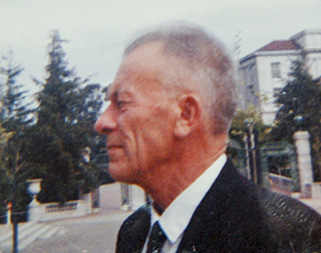
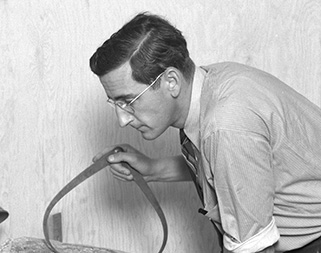
Click on any image in the top row to see a larger version. Top left: Huff's ceramic plaque of Charles Camp with caption on the Wall of Comparative Ovations. Photo by David Smith. Top center: Huff's ceramic plaque of V.L. VanderHoof and caption. Photo by David Smith. Top right: Huff's ceramic plaque of Antonio de la Guerra is on the front of the Old Timers Museum and is not really part of the Wall of Comparative Ovations. Photo by David Smith. Bottom left: This photograph of Charles Camp, circa 1960, was undoubtedly used by Huff when working on his Camp plaque. HFA. Bottom right: This 1940 photograph was the basis for Huff's plaque of VanderHoof. From UCMP's Large Format Negative Collection.
Whimsical E Clampus Vitus drawings
Huff made many friends within E Clampus Vitus and was inspired to do a number of whimsical drawings of some of his fellow Clampers; it's possible that Huff may have made these for Clamper greeting cards1. Others, with comic historical themes or anthropomorphized animals, may or may not have had some relation to ECV. The characters and situations depicted in Huff's drawings may have their origins in Clamper lore, but more than likely they were products of Huff's own imagination. He produced a number of whimsical drawings that seemed to have no connection to ECV yet they dealt with similar absurd people and events.
It is difficult to say just when these drawings were made—in typical Huff fashion, he did not date any of them, however, a couple handwritten notes would suggest that those of ECV members were done in the early 1940s and 1950s while those with the animals were drawn in the early 1970s.2
Only those drawings that have a clear ECV connection are shown below; the non-ECV whimsical drawings are shown on page 6. There is no way of knowing how many of these sorts of drawings Huff actually created during his lifetime.
Click on any image to see a larger and complete version. Top row: From the left are an ink drawing of Adam Lee Moore; an ink drawing of Charles Camp; an ink drawing of V.L. VanderHoof; a drawing of Leon Whitsell; and a drawing of John Porter. All images from the HFA. Bottom row: From the left are a drawing of Edgar Jessup; an ink drawing of Hale Sparks; a photograph of Hale Sparks (left), a UC Berkeley student and Huff (with his life-size Bison latifrons head) that was clearly the basis of Huff's drawing of Sparks; an ink drawing of Ronald Olson and a second, unknown figure. Whitsell and Porter drawings from AHR; all other images from the HFA.3
Click on any image to see a larger and complete version. Left: An ink drawing of Henry R. Wagner. HFA. Second from left: A charcoal pencil drawing of Wagner. AHR. Third from left: Huff designed this medal featuring Wagner's likeness for the California Historical Society. Ironically, Charles Camp was the recipient of one of these medals. AHR. Right: This drawing is not of Carl Wheat but was made for an event honoring the historian. AHR.4
Click on any image to see a larger and complete version. Left: A drawing of a character that Huff called Alcibiades La Rue. AHR. Second from left: Drawing of a cartoonish monarch called Emperor X. AHR. Third from left: A pen and ink version of the Emperor X character. Here Huff gives him a different name. HFA. Right: A ceramic plaque on the Wall of Comparative Ovations. The caption reads "OLIVER SANDAB. Oliver arrived in Murphys from Albania during the Gold rush—struck it rich—lost it all in crap game. Later became dirt farmer in wilds near Milpitas. Cut off from all contact with ECV, branded animals became his fellow Clampers. He was happy no end and not the least bit lonely. Restoration (based on tintype) by Prof. Alcibiades La Rue." Photo from the HFA.
Click on any image to see a larger and complete version. Left: A drawing that became a ceramic plaque for the Wall of Comparative Ovations in Murphys, CA. The caption for this plaque reads "CIRCA 15,000 B.C. Oldest known piece of Clamper art extant, found in Los Angeles County. It depicted what happened to Clampers who ventured into the open unarmed. The protective weapon carried was called huba-hubba. (In modern Clamper parlance it is known as the Staff of Relief.) Credo Quia Absurdum." AHR. Center: Huff's bas-relief based on the previous drawing. HFA. Right: Another drawing that became a ceramic plaque for the Wall. The caption for this one reads "INCIDENT NO. 3. (Described by Professor Alcibiades La Rue) This 'incident' was witnessed by a group of Clampers, who had been drinking the potent 'Mother-Lode-Grape-Juice-Special.' Shortly after leaving the ECV saloon they found themselves wandering in the country where the above apparition appeared. They swore the figure (with pack) was none other than 'Moose' Hardliany, ex-bartender, who created the recipe for MLGJS." Drawing from AHR.
Here we will return to a roughly chronological account of Huff's life, beginning where we left off with Huff's involvement with the Golden Gate International Exposition of 1939-1940.
